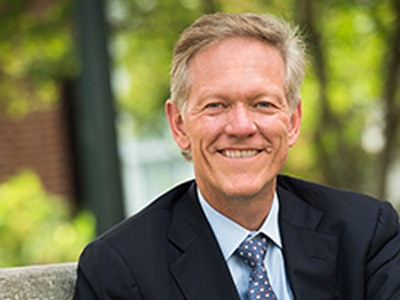Scott Beardsley first heard the term “nontraditional leader” several years ago when he tried to make the jump from being director of a management consulting firm to president of an Ivy League college.
“I was told that you’re a nontraditional leader and that’s complicated,” Beardsley recalled being told by an executive search firm as tried to become president of Dartmouth College back in 2012 and 2013.
 Scott Beardsley
Scott Beardsley“I said, ‘What’s that mean? What’s that word you’re calling me?’” recounted Beardsley, who is now dean and Charles C. Abbott Professor of Business Administration at University of Virginia Darden School of Business.
“I started getting different answers to the question, so I got really curious as to what this whole debate was about –a nontraditional or traditional leader,” Beardsley said. “So I decided to explore it deeper.”
That deeper exploration led to a dissertation that ultimately culminated in a new book being released Wednesday titled Higher Calling: The Rise of Nontraditional Leaders in Academia.
Among other things, the book — published by the University of Virginia Press — seeks to quantify just how many of today’s college presidents are considered nontraditional and what that means for some of the most essential aspects of higher education, such as fund-raising and enrollment.
Beardsley said the first thing he learned in doing his research is that not everyone agrees on what makes a college president traditional or nontraditional.
“It’s sort of like saying, ‘What is diversity?’” Beardsley said. “If you ask 10 different people, you get 10 different answers to the same thing.”
To solve the problem of defining what makes a college president nontraditional, Beardsley came up with his own definition.
“If you were ever on the tenure track, then you are traditional,” Beardsley explained during a recent sit-down with Diverse. “And if you never were, you’re nontraditional.”
Whereas in the 1950s and 1960s tenure track was the primary pathway to the college presidency, today that is no longer the case, Beardsley said.
“My research suggests that two-thirds were on the tenure track and one-third were not,” Beardsely said of his findings of today’s college presidents. “So one-third, by my definition, were non-traditional.”
Beardsley said there is no evidence that those who come from the world of business — as he did — are any better at fundraising or boosting enrollment than those who come from academe. However, he found that nontraditional college presidents tend to stay on the job longer than traditional college presidents.
For instance, one table in his book shows that nontraditional liberal arts presidents stayed on the job for an average of 8.3 years versus 6.2 years for traditional liberal arts presidents.
But Beardsley cautioned not to draw any inferences from that because it could be that traditional college presidents are being “poached” for their next job.
Beardsley also found that most — but not all — nontraditional leaders tend to work at lower ranked colleges and are also more likely to work at religiously affiliated schools.
Beardsley cautioned against getting caught up in the binary nature of the discussion.
Asking if an institution should hire a traditional leader or a nontraditional leader is the wrong question, Beardsley said.
“The right question is: What are the leadership challenges faced by my institution and where can I find the right leader to meet those challenges?” Beardsley said. “If your institution is facing a need for great fundraising, to innovate using technology or go global, whatever the particular challenge is, is the candidate I have able to do that?”
Whether the candidate was ever on the tenure track or comes from the world of business is “almost irrelevant,” he noted.
“What’s really relevant is, ‘Am I confident this person can raise the money necessary or can this person unify the campus or can this person innovate and try new things?’” Beardsley said.
“Higher education just needs great leadership,” Beardsley said. “A leader that has been through the tenure-track ranks and has no understanding of running a complex business, which is a not-for-profit business called higher education, that’s not helpful,” Beardsley said. “And also somebody who has come through the managerial ranks who has no understanding of higher education, that’s also not very helpful.”
He added, “So if you have somebody who knows how to do both, that’s what you need. Each institution faces its own set of challenges and you need to find that leader that can best fit the problems that you need to solve.”
Asked for examples of nontraditional presidents who were doing an exemplary job, Beardsley mentioned two of his former classmates from the University of Pennsylvania, where he earned his doctorate in higher education management — with distinction — in 2015.
One of them is Paul Quinn College president Michael Sorrell, a Duke law school graduate who once led President Bill Clinton’s Initiative on Race, and Michael P. Schneider, president of McPherson College. He notes how both Sorrell and Schneider have done innovative things on campus. Sorrell, for instance, converted a football field into an organic farm, while Schneider’s school has students restore classic cars as a way to teach them about experiential learning.
“Those are just two that I know and admire,” Beardsley said. “There’s thousands of higher education institutions but those two I find are very interesting stories and amazing people.”
Jamaal Abdul-Alim can be reached at [email protected] or you can follow him on Twitter @dcwriter360.



















